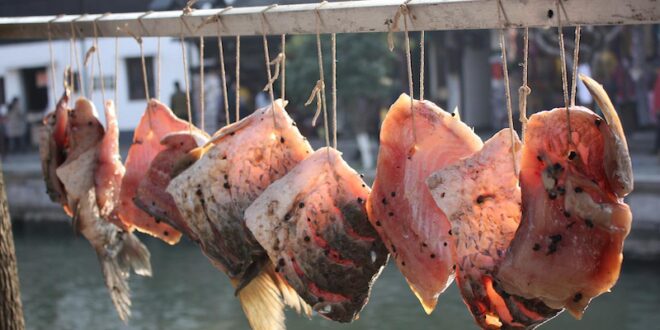China has made great efforts to meet increasing domestic food demand over the past four decades. From 1978–2021, China’s real agricultural output grew on average 5.4 per cent a year (over five times the population growth), with increased diversification towards high protein and high-value products. Yet a substantial gap remains between food demand and domestic supply — and is expected to increase.
In 2021, net imports of grains were 165 million tonnes, including 96.5 million tonnes of soybeans (58.6 per cent) and 10.4 million tonnes of cooking oils (6.3 per cent) and 28.35 million tonnes of corn (35.1 per cent), accounting for around a quarter of domestic production.
Given their high-quality protein and relatively low production costs, aquaculture products are seen as having higher economic value than the livestock industry — both as food and substitutes for feed grains. This makes aquaculture a prioritised industry in China — the world’s biggest fisheries subsidiser — that could help decrease the gap between food demand and supply.
Between 1980 and 2020, the annual growth rate of China’s fishing industry total output averaged 6.7 per cent a year, comparable to the livestock industry (6 per cent a year) for the same period. In 2020, the total output of China’s fishing industry was 65.49 million tonnes, 52.24 million tonnes of which came from domestic freshwater and offshore aquaculture. This makes China the leading aquaculture producer and exporter in the world, accounting for 60 per cent of global aquaculture production in 2019.
Aquaculture in China has experienced an expansion in output, including rapid change in its output structure and way of production over the past four decades. Driven by ongoing policy reforms and increasing economic concerns, China’s aquaculture production focusses on freshwater and offshore aquaculture as opposed to its focus on fish catching in the 1980s.
Offshore aquaculture produced 20.65 million tonnes of seafood in 2020, accounting for 40 per cent of total aquaculture output. Mussels, oysters and scallops ranked as the top three seafood products (accounting for 35 per cent, 28 per cent and 13 per cent of seafood production respectively), while fishery products accounted only for 7.3 per cent of the market.
Regarding the geographical distribution of offshore aquaculture, the majority of offshore aquaculture activities are located along the northern and southern coasts of China’s exclusive economic zone. 46.7 per cent of sea fishing and farming in 2020 came from the Huanghai and Bohai Seas, 29.5 per cent from the East China Sea and 23.5 per cent from the South China Sea. Less than 15 per cent came from far-sea catches.
Looking to the future, increased per-capita food demand in both quantity and quality will further drive up the need for more aquaculture products in China. According to the recent forecast by the Chinese Academy of Engineering, total aquaculture demand and consequently production will grow from approximately 81 million tonnes to 100 million tonnes by 2035. This growth imperative puts great pressure on domestic aquaculture production competing for limited feed supply.
In addition to freshwater aquaculture such as molluscs and carp, higher trophic species raised in offshore waters may also increase domestic supply in the future. The industry needs to substantially increase its production and efficiencies in resource usage. Yet challenges arise from increasing environmental constraints, bottlenecks in technological and feed development, interactions between political narratives and policy development and the availability of seafood and feed resources globally.
To resolve the issues facing future aquaculture development in China, a new guiding principle has been initiated in the 14th Five Year Plan (for 2021–2025). This new guideline emphasises sustainable production for directing future aquaculture development in China and is expected to be achieved through productivity enhancement. As evidence, wild capture fisheries have already been strictly restricted for the 2016–2020 period and their output in absolute and relative proportion of total aquaculture output has been declining over the same period.
Parallel to speeding up domestic production in freshwater and offshore aquaculture, China is also actively extending its capability to outsource increasing demand. On the one hand, China is increasing its efforts in far-sea fishery resource exploration along with increased vessel-building capacity and technological progress. At the same time, China is increasing its trade and investment overseas to increase the import of aquaculture products.
This is a strong indication that China’s current strategy is to move towards a market-based, demand-driven economy for aquaculture products, along with the Belt and Road Initiative. While outsourcing from international markets is an attractive option, this strategy depends on whether China can access sufficient production internationally. Either way, the consequences are expected to have great implications for the rest of the world.
 Eurasia Press & News
Eurasia Press & News


